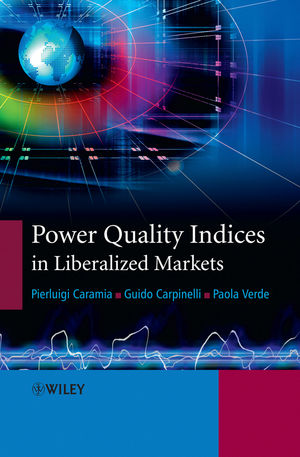Power Quality Indices in Liberalized MarketsISBN: 978-0-470-03395-1
Hardcover
288 pages
September 2009
 |
||||||
Preface.
Acknowledgements.
1 Traditional power quality indices.
1.1 Introduction.
1.2 Background concepts.
1.2.1 Power quality disturbances.
1.2.2 Power quality disturbances and electromagnetic compatibility.
1.3 Power quality disturbances: indices and objectives.
1.3.1 Waveform distortions.
1.3.2 Slow voltage variations.
1.3.3 Unbalances.
1.3.4 Voltage fluctuations.
1.3.5 Mains signalling voltages.
1.3.6 Voltage dips (sags).
1.3.7 Transient overvoltages.
1.3.8 Rapid voltage changes.
1.4 Conclusions.
References.
2 Assessing responsibilities between customer and utility.
2.1 Introduction.
2.2 Waveform distortions and voltage unbalances: indices based on a single metering section.
2.2.1 Indices based on harmonic impedances.
2.2.2 Indices based on powers in non-ideal conditions.
2.2.3 Indices based on comparison with an ideal linear load.
2.3 Waveform distortions and voltage unbalances: indices based on distributed measurement systems.
2.3.1 The global index.
2.3.2 The cost of deleterious effects index.
2.4 Voltage fluctuations.
2.4.1 An approach based on the correlation between flicker level and load power.
2.4.2 An approach based on Gaussian probability functions.
2.4.3 Summation law-based approaches.
2.4.4 Voltage-based approaches.
2.4.5 Voltage and current-based approaches.
2.4.6 Power-based approaches.
2.4.7 A simplified approach.
2.5 Voltage sags.
2.5.1 Disturbance power and energy approach.
2.5.2 Slope of the system trajectory approach.
2.5.3 Resistance sign approach.
2.5.4 Real current component approach.
2.5.5 Distance relay approach.
2.6 Voltage transients.
2.7 Conclusions.
References.
3 Advanced methods and nonstationary waveforms.
3.1 Introduction.
3.2 Discrete time waveforms and windowing.
3.2.1 Hanning windowing.
3.2.2 Result interpolation.
3.2.3 Synchronized processing.
3.2.4 Desynchronized processing.
3.3 Short-time Fourier transform.
3.3.1 Theoretical background.
3.3.2 STFT-based indices.
3.4 Wavelet transform.
3.4.1 Theoretical background.
3.4.2 Wavelet-based indices.
3.5 Parametric methods.
3.5.1 Theoretical background.
3.5.2 Parametric method-based indices.
3.5.3 Some comparisons between DFT-based methods and parametric methods.
3.6 Time–frequency distributions.
3.6.1 Theoretical background.
3.6.2 Time–frequency distribution-based indices.
3.7 Transient waveform distortions (bursts).
3.7.1 Theoretical background.
3.7.2 Burst indices.
3.8 Conclusions.
References.
4 Quantifying the quality of the overall supply voltage.
4.1 Introduction.
4.2 Global indices based on a comparison between ideal and actual voltages.
4.2.1 The normalized RMS error.
4.2.2 The normalized three-phase global index.
4.2.3 The voltage quality deviation factor.
4.3 Global indices based on the treatment of traditional indices.
4.3.1 The global indicator.
4.3.2 The unified power quality index.
4.4 Global indices based on the economic impact on the customer.
4.5 Comparisons of global indices.
4.6 Conclusions.
References.
5 Distribution systems with dispersed generation.
5.1 Introduction.
5.2 Power quality variation indices.
5.2.1 Site indices.
5.2.2 System indices.
5.3 Impact system indices.
5.4 Conclusions.
References.
6 Economic aspects of power quality disturbances.
6.1 Introduction.
6.2 Economic impact of power quality disturbances.
6.2.1 Cost of voltage dips in deterministic scenarios.
6.2.2 Cost of harmonics in deterministic scenarios.
6.2.3 Cost of voltage dips in probabilistic scenarios.
6.2.4 Cost of harmonics in probabilistic scenarios.
6.3 Some economic mechanisms for improving power quality levels.
6.3.1 USA: a mechanism based on the harmonic-adjusted power factor.
6.3.2 USA: a proposal based on the service quality index.
6.3.3 Argentina: a mechanism based on the equivalence between voltage quality and continuity.
6.3.4 Colombia: a mechanism based on the customer’s perception of the impact of each disturbance.
6.3.5 Iran: a proposal based on a penalty function depending on the type of customer.
6.3.6 Italy: a mechanism based on the unified power quality index.
6.3.7 Various countries: power quality contracts.
6.4 Conclusions.
References.
Index.



